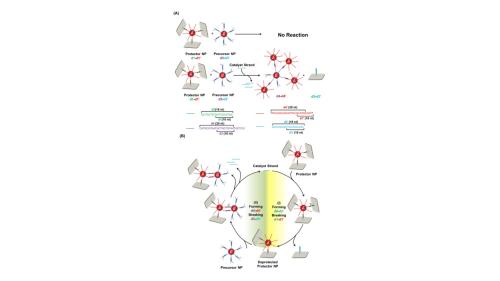Technologies Available for License
Category: biotechnology & health
2016-016: Nanoparticle-Based Molecular Amplification Reactions for DNA Based Sensing and Detection
Invention: 2016-016
Patent Status: U.S. Patent Number 11,866,775 was issued on January 9, 2024
For technical and licensing related questions, email tcp@bnl.gov.
Summary

Figure: (A) Illustration of the concept. protector NP(A) is a 20 nm AuNP protected by ~3-5 DNA ori-gami structures using 10 bp d1-d1` hybridization and precursor NP(B) conceals ~300 copies catalyst strands using d3-d3` hybridization. Upon addition of a minuscule amount of catalyst strands, the system undergoes an irreversible aggregation due to more favorable d2-d2` and d4-d4` hybridization, releasing more catalyst strand which trigger further aggregation of particles. (B) Step-by-step toehold mediated aggregation and isothermal amplification of DNA molecule. In step (i), an 18 bp long d2-d2` duplex is formed by breaking 10 bp long d1-d1` duplex via a toehold-mediated exchange reaction. This expels origami structure from, exposing many active red strands complementary to purple strands grafted onto precursor NP(B). In step (ii), more energetically favorable d4-d4` duplex is formed releasing more cata-lyst strand in solution. The released catalyst strands can initiate cycles which resul
Deoxyribonucleic acid (DNA) has emerged as a preferred material designing artificial molecular networks because of its predictable and programmable interactions as well as intrinsic nanoscale size. However, the molecular signals generated are typically at the low concentrations. For enabling new sensing modes robust amplification strategies are needed. Scientists at Brookhaven have designed a molecular amplification process, analogous to an electronic transistor or an autocatalytic reaction, where large output signal can be generated by nanoparticle-based amplification device from a low input signal. By using a small amount of DNA molecule as an input, a few hundred times higher output of the same molecular species is generated through several cascading isothermal toehold exchange reactions in solution at room temperature. The novel nonenzymatic amplification strategy has potential application in bio-sensing.
Description
The described isothermal molecular amplification method can be used to identify a specific DNA of interest. When the molecule of interest (e.g., DNA with specific input sequence) is identical to the DNA on the stored particles, then through a series of reaction between nanoparticles results in a set of output DNA molecules that is larger in number than the input DNA molecules, thereby helping in the identification of minute amounts of DNA of interest without using an enzymatic process.
Benefits
This strategy is isothermal and enzyme free and can lead to a maximum of 300-fold enhancement of molecular signal based on steric inhibition of DNA origami structures and serial strand displacement cascade reactions. This amplification is also accompanied by visual aggregation of gold nanoparticles.
Applications and Industries
To develop DNA based sensing and detection system.
Journal Publication & Intellectual Property
- US 11,866,775 B2 (.pdf)
Tags: DNA
Contacts
-

Poornima Upadhya
Manager Technology Transfer & Commercialization
Technology Commercialization
(631) 344-4711, pupadhya@bnl.gov
-

Avijit Sen
IP Licensing & Commercialization
Technology Commercialization
(631) 344-3752, asen@bnl.gov




